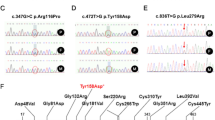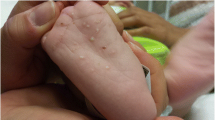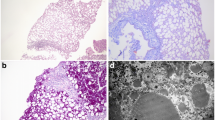Abstract
Background
Primary hypertriglyceridemia (HTG) is a very rare autosomal recessive disorder caused by the mutations of the genes related with triglyceride metabolism, including apolipoproteins and lipoprotein lipase (LPL) among others. Germline mutations in the LPL gene cause familial LPL deficiency with an incidence of about 1:1,000,000. It is often diagnosed in childhood and consanguinity is common.
Case presentation
We present here a LPL nonsense variant in an infant with heterozygous carriers (parents) of one of each variation detected in the infant. The infant presented with recurrent vomiting, diarrhoea, and haematochezia at 1 month of age. A diagnosis of familial HTG in the infant was made from the clinical manifestations and observation of a lipemic blood sample. Next-generation sequencing identified two pairs of variants in the LPL gene in the patient: chr8:g.19961024G>A; c.1263G>A; p.Trp421Ter and chr8:g.19962221T>G; c.1427+2T>G which were confirmed and validated by Sanger sequencing. The nonsense variant in exon 8 (chr8:g.19961024G>A (HET); c.1263G>AC; p.Trp421Ter) of the LPL gene was detected only in the father, while the 5ʹ splice site variant in intron 9 (chr8:g.19962221T>G (HET); c.1427+2T>G) was detected only in the mother. Thus, the infant manifesting HTG inherited one recessive gene from each of the carrier parents. There were no de novo mutations in the index patient. Based on the clinical findings and genetic test results, it was concluded that the infant suffers from compound heterozygous familial HTG.
Conclusions
The current case of the infant with germline mutations in the LPL gene resulting in very severe HTG highlights the importance of genetic counseling. Genetic identification of the pathogenic variants is essential to strategize genetic therapy whenever feasible. The consanguineous nature of the parents is the most probable identified risk factor for the germline mutation in the LPL gene.
Similar content being viewed by others
Background
Primary hypertriglyceridemia (HTG) is a very rare autosomal recessive disorder caused by the mutations of the genes related with triglyceride (TG) metabolism, including apolipoprotein C-II (APOC2), apolipoprotein A-V (APOA5), glycosylphosphatidylinositol-anchored high density lipoprotein-binding protein 1 (GPIHBP1) and lipase maturation factor 1 (LMF1) and lipoprotein lipase (LPL) (Shah and Wilson 2020; Li et al. 2020; Oh et al. 2020) (Table 1). Germline mutations in the LPL gene cause an enormously rare autosomal recessive familial lipoprotein lipase deficiency (LPLD) often diagnosed in childhood and has an incidence of about 1:1,000,000. (Wu 2021) Familial LPLD has an autosomal recessive mode of inheritance, and consanguinity is common (Babirak et al. 1989). Patients with LPLD manifest as severe (serum TG level > 1000 mg/dL) and very severe (serum TG > 2000 mg/dL) HTG and develop hepatosplenomegaly, abdominal pain, lipaemia retinalis with a progressive risk of pancreatitis (Oh et al. 2020).
The LPL gene has 10 exons and encodes the lipoprotein lipase enzyme, which consists of 448 amino acids besides a signal peptide comprising 27 amino acids (Al-Serri et al. 2021).
Several missenses, nonsense, and silent mutations of LPL have been identified for the coding region besides the splice donor and acceptor variants in the introns, which are the non-coding regions (Li et al. 2020). Mutations within the introns create alternative splice sites leading to aberrant protein synthesis (Li et al. 2020).
Case presentation
In this article, we report a LPL nonsense variant in an infant with heterozygous carriers (parents) of one of each variation detected in the infant. Hence, these are compound heterozygous pathogenic variations detected in the infant.
The infant at term was born to consanguineous parents and his anthropometric parameters were normal at birth and presentation (Fig. 1). The patient was referred to our hospital by a local paediatrician when the infant suffered recurrent vomiting, diarrhoea, and haematochezia at 1 month of age (Fig. 2).
The initial laboratory investigations revealed the presence of anemia with hemoglobin of 7.2 g%. Whole blood when allowed to stand at 4 °C overnight led to the development of the Lipemic plasma and the corresponding TG concentration was 36,400 mg/dL. The USG demonstrated mild hepatosplenomegaly and pancreatitis with unremarkable kidneys.
Ophthalmic examination revealed bilateral lipemia retinalis which is an unusual retinal manifestation of chylomicronemia or HTG. Hence, lipoprotein electrophoresis was performed which showed increased pre-beta lipoprotein, lipoprotein below the detection limit (< 2.0), and the presence of chylomicrons (Fig. 3).
Subsequently, over almost 4 years, the infant recurrently suffered abdominal pain with hematochezia, hepatosplenomegaly, ascites, vomiting, and pancreatitis with severely elevated triglyceride (> 2000 mg/dL) and abnormal lipase enzyme levels.
Thus, the presentation of familial HTG in the infant was made from the observation of a lipemic blood sample, recurrent abdominal pain, and acute pancreatitis which are typical of familial HTG (Fig. 4).
Required dietary modifications were recommended along with pharmacotherapy which included Docosahexaenoic acid (DHA) Eicosapentaenoic acid (EPA) and fenofibrate to regulate levels of cholesterol and triglycerides.
Genetic findings
The next-generation sequencing (NGS) data analysis of our patient identified variants in the LPL gene. The same variation was validated by Sanger sequencing to confirm the likely pathogenic variants. Likely compound heterozygous variants causative of the reported Phenotype were identified.
Exon 8 and intron 9 of the LPL gene were polymerase chain reaction (PCR)-amplified and the products were sequenced using Sanger sequencing. The sequences were aligned to available reference sequences ENST00000650287.1 to detect variations using variant analysis software programs.
NGS identified two pairs of variants in the LPL gene in our patient.
chr8:g.19961024G>A; c.1263G>A; p.Trp421Ter and chr8:g.19962221T>G; c.1427+2T>G which were confirmed and validated by Sanger sequencing. The variant analysis in Sanger sequencing was based on the reference sequence ENST00000650287.1 of LPL.
A heterozygous nonsense variant in exon 8 of the LPL gene (chr8:g.19961024G>A; c.1263G>A) led to a stop codon and premature truncation of the protein at codon 421 (p.Trp421Ter). The single base alteration of guanine in exon 8 by adenine transversion occurred at position 243. The substitution (c.1263G>A) led to the replacement of tryptophan (TGG) at codon 421with a termination codon (TGA) p.Trp421Ter (Fig. 5a).
Additionally, a heterozygous 5ʹ splice site variant in intron 9 of the LPL gene (chr8:g.19962221T>G) was also detected. Thymine was substituted by guanine in intron 9 at position 258. The substitution (chr8:g.19962221T>G) affects the invariant GT donor splice site of exon 9 (c.1427+2T>G) (Fig. 5b). This led to the loss of wild‐type donor splice site tailed by the anomalous splicing of LPL mRNA resulting in the formation of substitute transcripts.
On evaluation, the father’s lipid profile was found to be normal; however the mother displayed mild elevations of triglycerides, non-HDL and VLDL (Table 2). They underwent genetic evaluation for these variants. The nonsense variant in exon 8 (chr8:g.19961024G>A (HET); c.1263G>AC; p.Trp421Ter) of the LPL gene was detected in the father but not in the mother, while the 5’ splice site variant in intron 9 (chr8:g.19962221T>G (HET); c.1427+2T>G) was detected in the mother but not in the father (Figs. 6a and b).
Thus, the infant manifesting HTG inherited one recessive gene from each of the carrier parents. There were no de novo mutations in the index patient (infant). Based on the clinical findings and genetic test results, we conclude that the infant suffers from compound heterozygous familial HTG.
Discussion
In the current case report, an infant presented with very severe HTG and AP. The patient presented with very severe HTG with typical manifestations of abdominal pain, pancreatitis, hematochezia, and recurrent vomiting. The whole exome sequencing identified two heterozygous mutations (chr8:g.19961024G>A; c.1263G>A) and (chr8:g.19962221T>G) in the LPL gene in the exon 8 and intron 9, respectively. The heterozygous transversion, c.1263G>A in exon 8, led to the formation of a premature stop codon and truncation of the protein at codon 421 (p.Trp421Ter). Possibly the truncated anomalous fragment is devoid of physiologic catalytic action. Thus, this may have led to the loss of function of LPL and consequent HTG.
Numerous LPL gene mutations have been previously reported (Han et al. 2020; Li et al. 2020, 2018; Anwar et al. 2020; Nakamura et al. 1996; Chan et al. 2006; Takagi et al. 1994; Evans et al. 2011; Hegele et al. 2018; Suga et al. 1998; Jap et al. 2003; Bertolini et al. 2000) (Fig. 7). Nonsense variants form approximately 10% of 200 reported pathogenic LPL mutations. Evaluation of LPL nonsense variants together with the clinical manifestations provides data regarding the etiology of HTG based on the genotype and phenotype association. Based on a recent study, there are about 21 patients with confirmed 12 LPL variants globally with four in exon 6, three in exon 8, two each in exon 1 and exon 2 and one in exon 3. Approximately 62% (13/21) are compound heterozygotes and the remaining ~ 38% (8/21) are homozygotes (Li et al. 2020).
Post-heparin lipolytic activity of these patients found that homozygotes showed between 0 and 15.6% activity of normal LPL enzyme. While in compound heterozygotes the activity levels were widely variable between 0 and 61%, with 77% of patients below 10% and one each at 40% and 55%. The triglyceride levels were inversely proportional to the level of LPL activity, with those below 10% activity suffering from severe to very severe HTG in the patients with compound heterozygous and homozygous variants. Almost all patients with severe and very severe HTG suffered from recurrent acute pancreatitis. Our patients with compound heterozygous severe HTG also suffered from recurrent acute pancreatitis.
Nevertheless, we cannot possibly generalize this proposition since few patients both infants and elderly with severely elevated TGs and no LPL did not develop acute pancreatitis, on the contrary, those with even > 50% LPL activity did suffer from recurrent acute pancreatitis (Li et al. 2020). Thus, the etiology of HTG is not straightforward.
The parents of the index patient have a consanguineous marriage and were found to have one variant of the LPL gene each. While the father was unaffected, the mother had milder form of HTG. Previously studies have reported that the lipid and lipoprotein profiles of heterozygous relatives of index patients often resembled those of patients with a mild form of familial combined hyperlipidemia (Yang et al. 1995) (Table 2). It is well-established that the offspring of consanguineous unions are susceptible to genetic disorders due to the expression of autosomal recessive gene mutations inherited from a shared ancestor (Anwar et al. 2020) and consanguinity is common in familial LPLD (Babirak et al. 1989). The nature of the biological relationship between parents is directly proportional to the risk of their descendants inheriting undifferentiated copies of pathogenic recessive genes (Anwar et al. 2020).
Conclusions
The current case of the infant with germline mutations in the LPL gene resulting in very severe HTG highlights the importance of genetic counseling. Genetic identification of the pathogenic variants is essential to strategize genetic therapy whenever feasible. The consanguineous nature of the parents is the most probable identified risk factor for the germline mutation in the LPL gene.
Patients perspective
The patient brought in as an infant is now 44 months old and his parents have been following up regularly. The parents feel the timely diagnosis helped obtain appropriate and prompt treatment.
Availability of data and materials
Data sharing is not applicable to this article as no datasets were generated or analyzed during the current study.
Change history
21 February 2023
A Correction to this paper has been published: https://doi.org/10.1186/s42269-023-01003-2
Abbreviations
- APOA5:
-
Apolipoprotein A-V
- APOC2:
-
Apolipoprotein C-II
- DHA:
-
Docosahexaenoic acid
- EPA:
-
Eicosapentaenoic acid
- Gpihbp1:
-
Glycosylphosphatidylinositol-anchored high-density lipoprotein-binding protein 1
- GT:
-
Guanine thiamine
- HDL-C:
-
High density lipoprotein-cholesterol
- HTG:
-
Hypertriglyceridemia
- LDL-C:
-
Low density lipoprotein-cholesterol
- LMF1:
-
Lipase maturation factor 1
- LPL:
-
Lipoprotein lipase
- LPLD:
-
Lipoprotein lipase deficiency
- NGS:
-
Next-generation sequencing
- PCR:
-
Polymerase chain reaction
- TG:
-
Triglyceride
- VLDL:
-
Very low-density lipoprotein-cholesterol
References
Al-Serri A, Al-Bustan SA, Al-Sabah SK, Annice BG, Alnaqeeb MA, Mojiminiyi OA (2021) Association between the lipoprotein lipase rs1534649 gene polymorphism in intron one with body mass index and high density lipoprotein-cholesterol. Saudi J Biol Sci 28:4717–4722
Anwar S, Taslem Mourosi J, Arafat Y, Hosen MJ (2020) Genetic and reproductive consequences of consanguineous marriage in Bangladesh. PLoS ONE 15:e0241610
Babirak SP, Iverius PH, Fujimoto WY, Brunzell JD (1989) Detection and characterization of the heterozygote state for lipoprotein lipase deficiency. Arteriosclerosis 9:326–334
Bertolini S, Simone ML, Pes GM et al (2000) Pseudodominance of lipoprotein lipase (LPL) deficiency due to a nonsense mutation (Tyr302>term) in exon 6 of LPL gene in an Italian family from Sardinia (LPL (Olbia)). Clin Genet 57:140–147
Chan AO, But WM, Lau GT, Tse WY, Shek CC (2006) A novel nonsense mutation in the LPL gene in a Chinese neonate with hypertriglyceridemia. Clin Chim Acta 368:120–124
Evans D, Arzer J, Aberle J, Beil FU (2011) Rare variants in the lipoprotein lipase (LPL) gene are common in hypertriglyceridemia but rare in type III hyperlipidemia. Atherosclerosis 214:386–390
Han P, Wei G, Cai K et al (2020) Identification and functional characterization of mutations in LPL gene causing severe hypertriglyceridaemia and acute pancreatitis. J Cell Mol Med 24:1286–1299
Hegele RA, Berberich AJ, Ban MR et al (2018) Clinical and biochemical features of different molecular etiologies of familial chylomicronemia. J Clin Lipidol 12:920-927.e924
Jap TS, Jenq SF, Wu YC, Chiu CY, Cheng HM (2003) Mutations in the lipoprotein lipase gene as a cause of hypertriglyceridemia and pancreatitis in Taiwan. Pancreas 27:122–126
Li XY, Pu N, Chen WW, Shi XL, Zhang GF, Ke L, Ye B, Tong ZH, Wang YH, Liu G, Chen JM, Yang Q, Li WQ, Li JS (2020) Identification of a novel LPL nonsense variant and further insights into the complex etiology and expression of hypertriglyceridemia-induced acute pancreatitis. Lipids Health Dis 19(1):63
Li X, Yang Q, Shi X et al (2018) Compound but non-linked heterozygous p.W14X and p.L279 V LPL gene mutations in a Chinese patient with long-term severe hypertriglyceridemia and recurrent acute pancreatitis. Lipids Health Dis 17:144
Nakamura T, Suehiro T, Yasuoka N et al (1996) A novel nonsense mutation in exon 1 and a transition in intron 3 of the lipoprotein lipase gene. J Atheroscler Thromb 3:17–24
Oh RC, Trivette ET, Westerfield KL (2020) Management of hypertriglyceridemia: common questions and answers. Am Fam Physician 102:347–354
Shah AS, Wilson DP (2020) Genetic disorders causing hypertriglyceridemia in children and adolescents. In: Feingold KR, Anawalt B, Boyce A, et al. (eds). Endotext [Internet]. MDText.com, Inc., South Dartmouth (MA). Available from: https://www.ncbi.nlm.nih.gov/books/NBK395571/
Suga S, Tamasawa N, Kinpara I et al (1998) Identification of homozygous lipoprotein lipase gene mutation in a woman with recurrent aggravation of hypertriglyceridaemia induced by pregnancy. J Intern Med 243:317–321
Takagi A, Ikeda Y, Mori A et al (1994) A newly identified heterozygous lipoprotein lipase gene mutation (Cys239–>stop/TGC972–>TGA; LPLobama) in a patient with primary type IV hyperlipoproteinemia. J Lipid Res 35:2008–2018
Wu YQ, Hu YY, Li GN (2021) Rare novel LPL mutations are associated with neonatal onset lipoprotein lipase (LPL) deficiency in two cases. BMC Pediatr 21(1):414
Yang WS, Nevin DN, Peng R, Brunzell JD, Deeb SS (1995) A mutation in the promoter of the lipoprotein lipase (LPL) gene in a patient with familial combined hyperlipidemia and low LPL activity. Proc Natl Acad Sci U S A 92(10):4462–4466
Acknowledgements
We would like to thank Ms.Seema Kalel for her editorial assistance.
Funding
The Authors received no funding for this case report.
Author information
Authors and Affiliations
Contributions
TA and PP were the treating physicians of the patient. TA performed the literature research. TA and PP wrote the manuscript. Both authors read, reviewed, and approved the manuscript.
Corresponding author
Ethics declarations
Ethics approval and consent to participate
Research subject’s parents were informed of the purpose and methods of the report, that participation was voluntary and that there would be no disadvantages if they refused, and about the protection of their personal information and withdrawal of consent. Written consent was obtained from the parents of the research subject. Since the case report was anonymized, it was determined that Ethics Committee approval was not required. Also as per the country guidelines ‘case report’ does not fit into the Ethics Committee approval requirement criteria list.
Consent for publication
Parents were informed in writing about the publication, that participation was voluntary, that they would not be disadvantaged if they refused, and that they would protect their personal information and withdraw their consent, and all agreed in writing.
Competing interests
The authors declare no competing interests.
Additional information
Publisher's Note
Springer Nature remains neutral with regard to jurisdictional claims in published maps and institutional affiliations.
The original version of this article was revised: “Author name correction”.
Rights and permissions
Open Access This article is licensed under a Creative Commons Attribution 4.0 International License, which permits use, sharing, adaptation, distribution and reproduction in any medium or format, as long as you give appropriate credit to the original author(s) and the source, provide a link to the Creative Commons licence, and indicate if changes were made. The images or other third party material in this article are included in the article's Creative Commons licence, unless indicated otherwise in a credit line to the material. If material is not included in the article's Creative Commons licence and your intended use is not permitted by statutory regulation or exceeds the permitted use, you will need to obtain permission directly from the copyright holder. To view a copy of this licence, visit http://creativecommons.org/licenses/by/4.0/.
About this article
Cite this article
Pawal, P., Aute, T. A nonsense germline mutation in the LPL gene in a 1-month-old infant: case report with review of literature. Bull Natl Res Cent 47, 16 (2023). https://doi.org/10.1186/s42269-023-00991-5
Received:
Accepted:
Published:
DOI: https://doi.org/10.1186/s42269-023-00991-5











